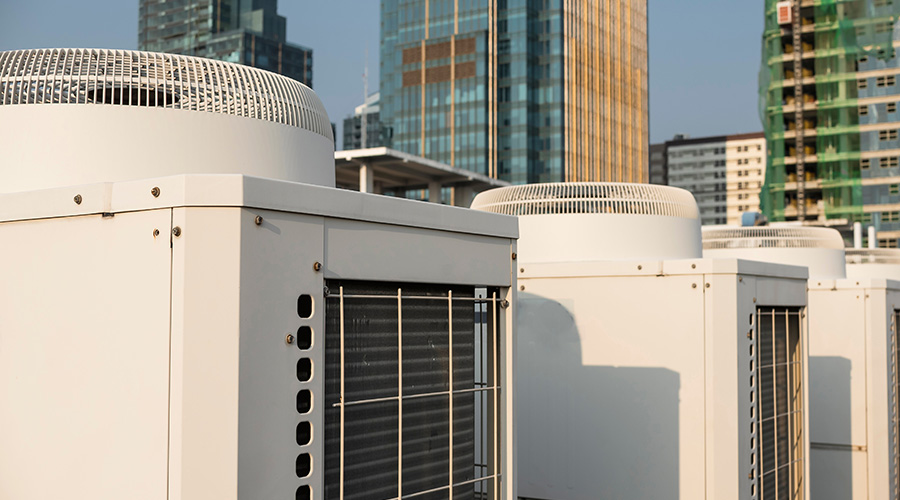Cleaning Up Our Act
Protecting the environment and safeguarding occupant health are two benefits of a green cleaning program
It was several years ago that Bill Thompson sometimes noticed janitors on his staff becoming lightheaded when using a particular floor stripper. Thompson, director of facilities for Lockport Township High School in Illinois, became concerned enough about the potential long-term impact of cleaning products that he decided to give green cleaning a try.
Thompson’s glad he did. Janitors don’t get dizzy anymore. Employees have told him they no longer get rashes since the strong cleaning solutions were replaced. What’s more, students also appear to have benefited, as attendance has increased by 2 percent since the program was put in place several years ago.
Concerns about the effect of harsh cleaning products on employees, as well as the environmental impact of chemicals used in many traditional cleaning products, are prompting a growing number of facilities to turn to green cleaning products and processes.
While firm statistics on the increase in the number of facilities taking a greener approach to cleaning are hard to come by, the trend has become mainstream, says Steve Ashkin, president of The Ashkin Group. “There’s no question that this issue has tipped,” he says, noting that as recently as four or five years ago, it was only early adopters who were looking at green cleaning.
Ashkin attributes the shift to several factors. Adoption of the concepts of sustainability and energy-efficiency by a number of large, high-profile organizations like General Electric and Wal-Mart has helped raise awareness and lend credibility to these issues. At the same time, LEED has provided a road map organizations can use to guide the implementation of their own green cleaning programs. And The Green Guide for Health Care gives guidance for facility executives in hospitals.
Moreover, many early adopters of green cleaning have found that their programs are either cost-neutral or provide a savings, says Jim Darr, a chemist in the pollution prevention division of the U.S. EPA. “It actually can cost less because of changes in work practices,” he notes.
At this point, no single definition of “green cleaning” exists. Ashkin suggests Presidential Order (PO) 13101. While it doesn’t specifically address cleaning, PO 13101 defines the term “environmentally preferable” as “products or services that have a lesser or reduced impact on human health and the environment when compared with competing products or services that serve the same purpose.” In other words, it’s not enough for a product to be good for the environment; if it’s also harmful to employees, it isn’t considered environmentally preferable. The reverse is true as well. “Green cleaning is cleaning that protects health without harming the environment,” Ashkin says.
Of course, taking a green approach to cleaning involves more than just the products that are used. It’s also important that employees use just the amount that’s really needed, and that they use the right product for the job, Darr says.
What’s In It for Me?
In any discussion of a potential move to greener products and practices, the first question that comes up is why anyone should make the switch. One reason is to minimize any harmful impact that the cleaning products and processes may have on the facility’s occupants and janitorial staff.
Occupants also can be affected. The No. 1 cause of absenteeism in schools is asthma, says Claris Olson, environmental health specialist with The Healthy Schools Campaign, a Chicago-based nonprofit focused on healthy school environments. “Poor indoor air quality can contribute to this.” Moreover, children are more vulnerable to chemical hazards and toxins than adults, due to their smaller body size.
In addition, organizations often can cut costs when they switch to a greener cleaning approach. The savings typically result from keeping a closer eye on how much of the cleaning products an organization uses. Under many traditional cleaning programs, each janitor’s closet can become a storehouse of scrubbers, detergents, and the like, many of which are rarely used, says Thompson. Since implementing a green cleaning approach, his staff can clean almost the entire school with just four products, all of which are certified by Green Seal.
On a broader scale, the growing adoption of green cleaning approaches will benefit the environment. The commercial cleaning business across the United States consumes some eight billion pounds of chemicals and 4.5 billion pounds of paper products each year, according to Ashkin. “Most people don’t understand how big the cleaning industry is,” he says.
What’s more, all those cleaning products are then rinsed down the drain and end up outside the building. Similarly, the air that’s inside a facility eventually will move outside, Darr notes.
Finally, shifting to green cleaning can help burnish a company’s image as being progressive and well-managed.
Going Green
The shift to a greener approach to cleaning can be made gradually. Thompson, for instance, started by replacing filters in the air-handling units with high-efficiency ones to reduce dust and irritants in the air. Next, he switched to environmentally preferable floor and window cleaners.
Thompson’s staff then tried different green products, one by one, to determine which worked most effectively. Once they decided on a product, the rest of the staff would start using it as well. “Our program grew gradually,” he says.
As Thompson and his staff know, research is key. A wealth of information on green cleaning products and processes is available online at no charge. (See below for more information.) “There already are good roadmaps,” Ashkin says.
The next step is an audit, Ashkin says. The goal is to find out what products and processes are currently used, and where there is room for improvement. Potential changes range from those that are fairly easy and low-cost, such as switching to environmentally preferable cleaning products, to those that require more substantial investments, such as purchasing a more efficient floor scrubber. Tackling the low-cost, low-hassle opportunities is an effective way to gain buy-in from employees. Once they see that one green product works as well as the products they’ve been using, they’re more apt to try another.
At the same time, it’s important to keep in mind that “there’s not a strict dichotomy between traditional and green cleaning,” Darr says. In fact, some tried-and-true cleaning products have minimal negative impact on the environment when used appropriately.
Along with evaluating the products used, green cleaning approaches incorporate a focus on the process. Staff training and education are key. “Behavior is the biggest barrier,” says Ashkin. It has become relatively easy to find products that are green. Supply has increased as awareness and demand have grown. However, simply purchasing the latest green products won’t result in full health or environmental benefits if employees use the product incorrectly or use the wrong amount.
To prevent overuse, Thompson uses ready-to-dispense systems that automatically provide just the amount of cleaning product needed, reducing the chance for waste. His experience has shown that without such a system, along with appropriate training, many janitors use more of the cleaning product than they need.
If employees know why they’re changing procedures or products, they’ll be more likely to support the shift to green products. It is also worthwhile to get them involved in choosing the new products. “If they have a voice in the evaluation of the products, they’re more likely to get on board,” says Olson.
Similarly, providing information to the facility’s occupants is helpful. Many people just assume that a bathroom isn’t really clean unless it smells like lemons or oranges or some other popular scent, Ashkin notes. If the occupants don’t detect that aroma, they may wonder if the facility is being thoroughly cleaned. For a green cleaning program to be sustainable over the long term, occupants need to understand how the cleaning process may change.
Accurate Claims
It’s also important to undertake a critical review of manufacturers’ claims that their products are green. As consumers have become more conscious of the impact their purchases and actions can have on the environment, more manufacturers have begun touting the “greenness” of their products. Their claims don’t always hold up. To confirm that a product truly is green, ask to see the results of any testing it has undergone, ideally by an independent testing organization, or look for a label that certifies the product’s impact on health and the environment. The certification should be from a credible, independent party.
It’s important to avoid overstating the extent to which a green cleaning approach will improve occupants’ health or productivity. To be sure, healthier indoor air quality should have a positive impact on both areas. However, stating that productivity will jump by a certain percent as a result of the shift may prompt occupants to question whether the green cleaning program is really working if they don’t see immediate, tangible results.
Facility executives who work with contract cleaning firms and are interested in moving to a greener approach need to follow a slightly different path. They’ll want to make sure that the contract with the cleaning contractor includes the criteria the program should meet, along with a process for monitoring and checking the results, Darr says. The facility executive may want to work with the outsourcing provider to ensure that its employees understand the reasons for the shift and the impact on the way they do their jobs.
Whether the staff is in-house or outsourced, green cleaning is moving into the mainstream. A growing number of facility executives have concluded that green cleaning is better for the cleaning crews, better for the environment and better for the building occupants. Thompson of Lockport Township High School is one of them. “With fewer products and chemicals and better, fresher air, we’re doing our job,” he says. “Now it’s up to the students.”
Resources on the Web:
- EPA’s Design for the Environment (DfE) Program:
The Design for the Environment (DfE) Program is a voluntary partnership program with a wide range of stakeholders to integrate health and environmental considerations into business decisions.
- ASTM:
ASTM E1971-05 is the Standard Guide for Stewardship for the Cleaning of Commercial and Institutional Buildings.
- Collaborative for High Performance Schools:
The Collaborative for High Performance Schools facilitates the design of high performance schools that incorporate energy- and resource-efficient environments and are healthy and comfortable.
- ISSA:
ISSA, the global cleaning industry association, provides articles and educational resources on green cleaning.
- Green Seal:
Green Seal provides credible, transparent, science-based environmental certification standards.
- Campaign for Healthy Schools:
The Campaign advocates for policies and practices that will allow all students, teachers and staff to learn and work in a healthy school environment.
- INFORM: Cleaning for Health:
INFORM is an environmental research and education organization.
|
Karen Kroll, a contributing editor for Building Operating Management, is a freelance writer who has written extensively about real estate and facility issues.
Related Topics:











